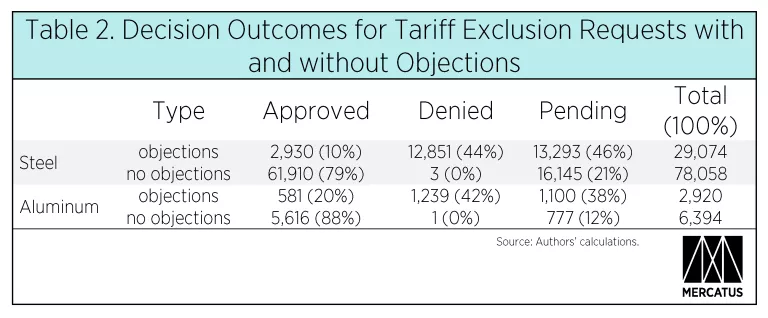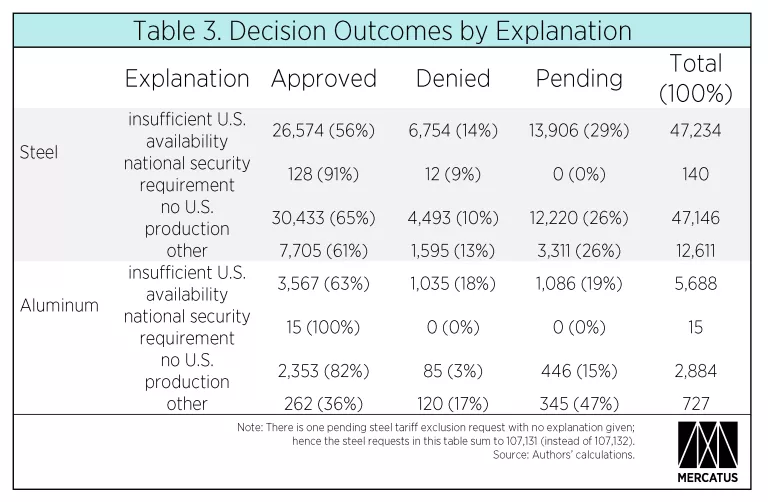- | Expert Commentary Expert Commentary
- |
Steel and Aluminum Tariffs Do More Harm Than Good
The incoming Biden administration should eliminate the Section 232 steel and aluminum tariffs that harm American industry
Since April there has been an increase in requests for exclusions from steel and aluminum tariffs—reflecting a heightened need by US manufacturers to escape the tariffs. The share of pending exclusion requests (those awaiting a decision) has decreased, which, combined with the uptick in the overall number of requests, means that the Commerce Department has been busy. But the sheer number of requests for exclusion from these tariffs indicates that they are harming American companies and workers.
The so-called Section 232 tariffs, which apply a section of U.S. trade law empowering the president to “adjust” trade for national security reasons, have benefited a relative handful of American companies that produce raw steel and aluminum. But this benefit has come at the expense of many more manufacturers and consumers.
Sachin Shivaram is the CEO of Wisconsin Aluminum Foundry, which employs about 420 people in Manitowoc, Wisconsin, making aluminum machine parts. We spoke to him by phone last week, and he said that when aluminum tariffs took effect in March 2018, they made raw materials expensive for the machine parts produced by the Foundry’s unionized workforce. By mid-2019, the company had to trim its workforce by about 12% in response to the tariff impacts.
The impact on Wisconsin Aluminum Foundry is not unusual, though the company has not sought exclusions because of the cost and uncertainty of success. And even though laid-off workers have been rehired, without the Section 232 tariffs, the Foundry’s products would be “maybe 10 to 15 percent more competitive, because we’d see that cost of the underlying commodity come down,” Shivaram estimates. “We make a part that is makeable by others. Our business is pretty competitive. At the end of the day, our profit margins are less than 10 percent, and so if we can become even that little bit more competitive, that could mean increased sales for us.”
Requests for Tariff Relief Have More Than Doubled
A new internet portal to house exclusion data was created in June 2019, replacing the old portal at regulations.gov. As a result, the data from regulations.gov and the new portal must be combined to get a full picture of exclusion activity.
Our latest update to the tariff exclusion request data shows that, up to this point, U.S. manufacturers have applied for steel and aluminum tariff relief more than 189,000 times through the Section 232 program’s “exclusion request” process. This means that compared with our previous update in April, the number of exclusion requests on the new portal has more than doubled from 54,201 to 116,446.
There have been 58,539 new steel tariff exclusion requests and 3,706 new aluminum tariff exclusion requests filed on the new portal. These figures represent a 120% increase in steel filings and a 66% increase in aluminum filings.
As table 1 displays, combining the data shows that there has been a total of 169,929 steel exclusion requests, of which 56% have been approved, 15% have been denied and 28% remain pending. For aluminum, there have been 19,288 exclusion requests, with 58% approved, 11% denied and 31% pending.

Among the biggest filers is Voest-Alpine High Performance Metals Corporation of Elgin, Illinois, which has filed the most steel tariff exclusions with 6,818 requests, of which 45% have been approved, 11% denied and the rest pending. Sigma Electric Manufacturing Corporation in Garner, North Carolina, has filed the most aluminum tariff exclusion requests, with all 843 approved.
Renewals Are More Likely to Get Approved Than New Requests
Some exclusion filings are requests for renewals of existing waivers. Since March 2020, approximately 22% of the steel exclusion requests, and 19% of the aluminum exclusion requests, were for renewals on the new portal. (To determine whether a filing was a renewal, we examined the information provided in the cell “Previous BIS.” If the information in that cell included a BIS number, we considered that to be a renewal request.)
Renewal requests have higher approval rates than new requests. Data from the new portal indicate that steel renewal requests have a 76% approval rate and 8% denial rate, with 15% pending. Aluminum renewal requests have an 82% approval rate and 8% denial rate, with 10% pending.
Objections Still Matter
Objections from steel or aluminum producers to tariff exclusion requests continue to have a material effect on decisions by the United States Trade Representative. Seventy-nine percent of steel tariff exclusion requests with no objections are approved, compared with only 12% of requests with one objection. Only 3% of the requests with multiple objections are approved.
For the aluminum tariff exclusion requests with no objections, 88% are approved, compared with only 31% of the requests with one objection and just 1% of the requests with multiple objections.
In other words, steel or aluminum tariff exclusion requests with objections, especially multiple objections, have a slim chance of getting approved, while those with no objections have a relatively good chance of approval.

Not surprisingly, the data also show that objections slow the exclusion decision process. Requests with at least one objection have a higher share still awaiting a decision. Specifically, the pending rate for steel exclusions with an objection is 46%, compared with just 21% without an objection. The pending rate for aluminum exclusions with an objection is 38%, compared with just 12% for those without.
The National Security Exemption
Exclusion requests that claim a national security requirement as an explanation are few in number but have a higher approval rate than those with other explanations: 91% of steel tariff exclusion requests with a national security requirement explanation are approved, and 100% of those for aluminum are approved. However, most requestors cite insufficient or no U.S. production as an explanation.

Next Steps
The concentrated beneficiaries of the Section 232 tariffs are already clamoring for the incoming Biden administration to keep them in place, while opponents are hopeful for relief.
One thing policymakers might consider is jobs. More communities depend on industries that use steel or aluminum than on industries that make it. Lydia Cox and Kadee Russ estimate that in steel alone, there are 80 Americans working in a steel-using industry for every one employed in steel production. So these tariffs, far from fulfilling their original purpose of helping American workers, are actually doing more harm than good for American workers.
Image Credit: Phynart Studio/Getty Images